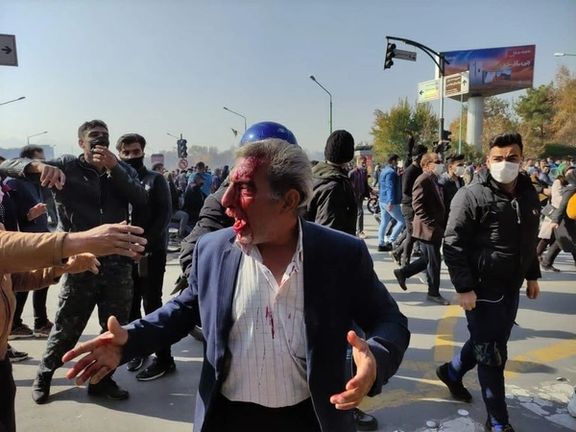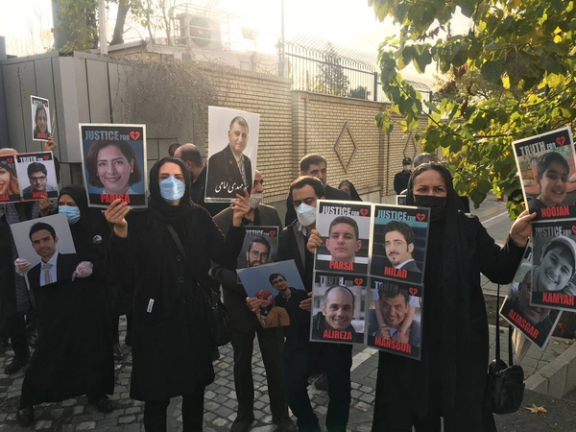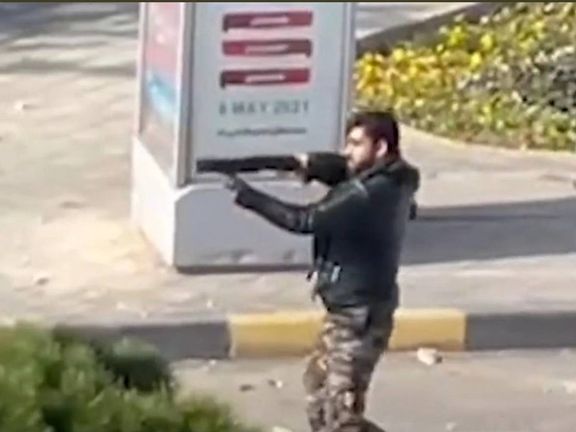Former Prison Guard On Trial In Sweden Denies Existence Of Mass Grave In Iran

A former Iranian prison guard on trial in Sweden for his role in killings of thousands of prisoners in 1988, denied any knowledge of a prisoner mass grave.

A former Iranian prison guard on trial in Sweden for his role in killings of thousands of prisoners in 1988, denied any knowledge of a prisoner mass grave.
Hamid Noury (Nouri) was arrested in November 2019 while visiting Sweden and charged with war crimes for his role in the execution of up to 5,000 political prisoners in Iran serving jail time. Sweden used the principal of universal jurisdiction to arrest and prosecute Noury, because the alleged crimes amounted to war crimes.
The cemetery called Khavaran is in southeast Tehran and an unmarked mass graveyard where at least dozens of executed prisoners are buried. Families of victims visit the cemetery regularly and lay flowers, although no one is certain about the exact identity of those buried in Khavaran.
Noury during the latest court session claimed he first heard about the graveyard when he was arrested in Sweden. He has also denied any role in the mass killings, although tacitly accepting that prisoners were executed. Dozens of witnesses, including prisoners who witnessed the summary trials in the summer of 1988, have testified in court against Noury.

Iran's state television Tuesday aired "confessions" of a young woman and man admitting to torching the tents of farmers protesting in Esfahan to provoke a riot.
The city protests, centered in the dried-up Zayandeh Roud riverbed, ended in security forces confronting the protesters with tear gas and shotguns on Thursday and Friday with at least 67 arrests and scores of injuries. "The confessions of these detainees show that the enemy cares nothing about the rightful demands of the farmers and the people of Esfahan," the program noted.
The two detainees − whose faces were obscured and voices distorted, purportedly to protect their identities − said they had poured fuel around the farmers’ tents in the early hours of Thursday.
"Burn the tents," the woman claimed she called out to her male companion, named as Mehdi. She said security forces were subsequently very polite "and pleaded with people to go home.”
The young man in the video said he had found empty tear-gas canisters that he used with red paint to create images of bloodshed for photos and films, presumably to circulate on social media.
Ophthalmologists in the past few days have reported tens of cases of eye injuries caused by shotgun pellets. A medical official told Iranian state television Saturday that 40 people had been treated for eye injuries sustained during the protests, with 19 hospitalized.
An injured eye has become a social-media symbol for the suppression of Friday's protests, with many activists posting images of bloody eyes or people holding bandage to an eye.

Iran has a long history of staged confessions of activists and those allegedly accused of ‘terrorist’ operations, including instances of people yet to be charged.
Tuesday’s program claimed that the two confessing to their role in Esfahan and others had played “a direct role in instigating the farmers to continue their protest." Other outlets, including Tasnim news agency, have circulated excerpts from the program including on Twitter alongside the caption "Confessions of a rioter woman in recent incidents in Esfahan.”
Authorities and hardliner media have accused some Esfahan protestors of being rioters and "agents of the enemies" who tried to highjack the farmers' legitimate protests over water shortages that have wracked the region in recent years. Kayhan newspaper called the protesters "America's foot soldiers" who perverted the water protests to "sow unrest and reap sanctions" ahead of Iran’s nuclear talks with world powers in Vienna, which resumed Monday. The chief of Esfahan province's justice department said Tuesday that those responsible would face speedy prosecution.

A former revolutionary says Supreme Leader Ali Khamenei is personally responsible for the "the atrocities committed" against peaceful protesters in Esfahan.
In a statement published on the ‘Kalemeh’ Telegram social-media channel Sunday, Abolfazl Ghadiani wrote that “all of the suppressive bodies…and their commanders are responsible for the [attack on] the peaceful, civil and non-violent protest of the people of Esfahan, but the central figure responsible for this aggression and the atrocities committed is Iran's dictator Ali Khamenei who must be held accountable.”
Ghadiani who was a political prisoner both during the monarchy and the Islamic Republic, blames the government for mismanaging water resources and accused security forces of setting fire to the tents of farmers protesting against a lack of water in the dry riverbed of Zayandeh Roud Thursday.
Ghadiani, who was imprisoned on charges of "propaganda against the regime" and "insulting the Supreme Leader" after the disputed 2009 presidential election, said security forces had “wounded a large number of protestors.”
Hasan Karami, a police commander, said Sunday that 2-3,000 "opportunists" had joined Friday's protests and that 67 had been arrested. The United States-based Center for Human Rights in Iran said Monday that at least 214 including 13 children had been arrested in total during the “recent protests.”
Social media users have posted photos of people with shotgun pellet injuries to their backs, legs and faces, including an old man with multiple pellet injuries to his back and a young boy who they claim lost both his eyes.
Iran International TV has obtained radiology images of a protester with tens of pellets embedded in his head, neck, and upper torso.

A medical official told Iranian state television Saturday that 40 people had been treated for eye injuries sustained during the protests, with 19 hospitalized. He did not specify how the injuries were sustained.
Chief Justice Gholam-Hossein Mohseni-Ejei said in a meeting of the judiciary's supreme council Monday that people had a right to look for solutions to their problems but warned them to be wary of the "enemies’ moves" and refuse to allow them to "infiltrate their ranks.”
He suggested that "ignorant people, ill-wishers and agents of foreign powers" had taken advantage of the protests seeking to "disturb people's peace and security."
Brigadier-General Abolfazl Shekarchi, spokesman of the armed forces, said that the “enemy wrongly thinks that the citizens of the Islamic Republic have turned their backs on it, do not want the authorities, and seek regime change."
Kayhan newspaper reported Sunday that "America's foot soldiers" had perverted the water protests to "sow unrest and reap sanctions" ahead of Vienna nuclear talks, which resumed Monday.

Iranian human rights groups abroad have reported on Sunday that 214 protesters in Esfahan have been arrested and 30 others are in hospitals with eye injuries.
Human Rights Activists’ News Agency (HRANA) reported that 13 of the detainees are juveniles, while authorities have not issued an official figure about the number of those detained. On two earlier occasions they had mentioned 120 and 67 people arrested.
Protests broke out on Friday after Esfahan residents came out to protest against mismanagement of water resources by the government that in time of drought has left the city’s main river and surrounding agricultural lands completely dry.
Security forces who had positioned themselves in all the main points in the city began using tear gas, batons and ‘bird shots’ from shotguns to disperse the protesters. Images on social media showed many protesters badly injured. There have been no confirmed cases of deaths.
Another human rights organization reported that 20 citizens are in area hospitals with eye injuries caused by shotgun fire. Arrests of citizens is still ongoing.
Hardliner media have called the demonstrators foreign agents, as they have done in past protests. Some even claimed that the United States instigated the protests to put pressure on the Iranian government just prior to nuclear talks set to resume in Vienna on Monday.

Victims’ families of an airliner downed by Iran in 2020 protested Sunday rejecting a trial of junior officers and demanding top officials to be held to account.
Holding pictures of their loved ones who died in the incident calling the trial a sham and “illegal”, demanding the prosecution of those in command and not low-ranking officers.
The protesters also chanted slogans against the Revolutionary Guard and Supreme Leader Ali Khamenei, while surrounded by a heavy presence of security forces.
Some of the victims’ families say that the downing of a Ukrainian flight from Tehran to Kiev after takeoff by two IRGC missiles was a premeditated act amid military tensions with the United States.
The plane with 176 passengers and crew was targeted on January 8, 2020, hours after Iran fired ballistic missiles at US bases in Iraq and was on alert for a possible retaliation. But authorities did not close the civilian airspace and tried to deny they had shot down the passenger plane.
Victims' families and critics say those on trial are not responsible for decisions taken at a higher level on the night of the incident. They say Amir-Ali Hajizadeh, the Revolutionary Guards aerospace commander was responsible because he did not “clear the airspace.”

Anti-government protests continued overnight in Esfahan as security forces attacked demonstrators with a variety of weapons and reportedly arrested 120 people.
As authorities restricted internet access in Esfahan and other cities, videos on social media showed groups of protesters shouting, “Death to the dictator”, and slogans against Iran’s intervention in Syria, demanding attention to the country’s internal problems.
Anti-riot police remained in the streets in large numbers, trying to end the protests that began two weeks ago by farmers from regions around the city, demanding water for irrigating their parched fields.
An Iranian human rights group said its preliminary information indicates authorities have arrested 120 people.
Security forces used tear gas, batons, and shotguns firing “bird shots” at demonstrators that inflicted serious injuries. Images and reports from local sources show that three people might have been killed, but a final toll has not been confirmed by the government or human rights activists monitoring the situation.
Mohammad-Reza Mir-Heidari, Esfahan’s police chief confirmed that citizens were injured but he also insisted that security forces were also hurt by stone-throwing protesters. He threatened “to deal” with protesters.